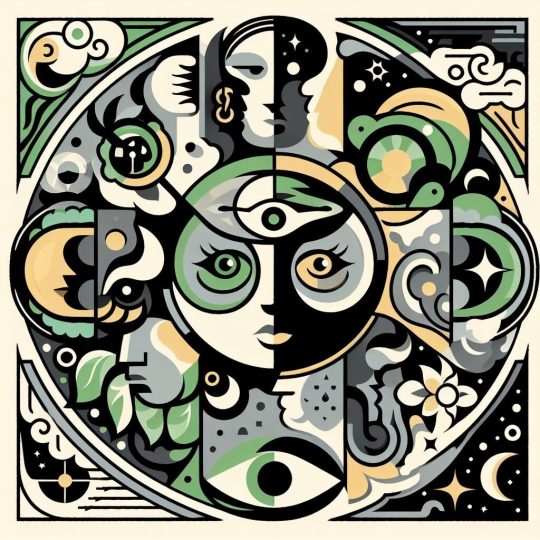
Who Was Carl Jung?
Carl Gustav Jung ( 1875–1961) was a Swiss psychologist and psychiatrist. Originally, he was a follower of Sigmund Freud. The relationship eventually fractured over Jung’s criticism of Freud’s emphasis on sexuality during development, which led Jung to develop his own psychoanalytic approach known as analytical psychology. While Jung agreed with Freud that the unconscious played an important role in personality and behavior, he expanded on Freud’s idea of the personal unconscious to include what Jung called the collective unconscious. Jung proposed and developed the concepts of the collective unconscious, introversion and extraversion. Jungian archetypes were defined by Carl Jung himself as universal, archaic symbols and images that derive from the collective unconscious.
What Are the Jungian Archetypes?
The word archetype comes from the Greek term archetypo – arche, meaning “original” and typos meaning “image”. Archetypes are universal, symbolic images or patterns of thought that are present in the collective unconscious, a term coined by Jung to describe the shared storehouse of human experience and knowledge. According to Jung, we all have access to this collective unconscious, and the archetypes within it can influence our thoughts, feelings, and behavior in ways that we may not even be aware of.
Archetypes have universal meanings across cultures and may show up in dreams, literature, art or religion. Jung believes symbols from different cultures are often very similar because they have emerged from archetypes shared by the whole human race which are part of our collective unconscious. For Jung, our primitive past becomes the basis of the human psyche, directing and influencing present behavior. He believed that we inherit these archetypes much in the way we inherit instinctive patterns of behavior.
Carl Jung published his archetypes which encompass key human roles and motifs in his works On the Nature of the Psyche (1954) and The Archetypes and the Collective Unconscious (1969). He suggested that the number of existing archetypes was not static or fixed. Instead, many different archetypes may overlap or combine, creating new archetypes such as the father (a stern, powerful authority figure), the hero (a champion, defender, or rescuer), and the trickster (a deceiver, liar, and troublemaker). Jung claimed to identify a large number of archetypes but paid special attention to four of them. Jung labeled these archetypes the Self, the Persona, the Shadow and the Anima/Animus.
The Persona
The persona (or mask) is the outward face we present to the world. It conceals our real self and Jung describes it as the “conformity” archetype. This is the public face or role a person presents to others as someone different to who we really are (like an actor).
The Anima/Animus
Another archetype is the anima/animus. The “anima/animus” is the mirror image of our biological sex, that is, the unconscious feminine side in males and the masculine tendencies in women. Each sex manifests attitudes and behavior of the other by virtue of centuries of living together. The psyche of a woman contains masculine aspects (the animus archetype), and the psyche of a man contains feminine aspects (the anima archetype).
The Shadow
Next is the shadow. This is the animal side of our personality (like the id in Freud). It is the source of both our creative and destructive energies. In line with evolutionary theory, it may be that Jung’s archetypes reflect predispositions that once had survival value.
The Self
Finally, there is the self which provides a sense of unity in experience. For Jung, the ultimate aim of every individual is to achieve a state of selfhood (similar to self-actualisation), and in this respect, Jung (like Erikson) is moving in the direction of a more humanist orientation.
The Four Cardinal Orientations
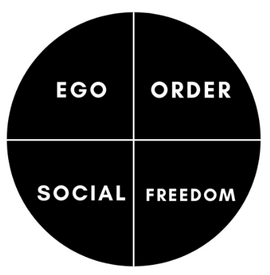
Jung stated the existence of four cardinal orientations: Ego, Social, Order, and Freedom. These orientations represent the range of basic human motivations. Each cardinal orientation has its own underlying “life motto” or inspiration:
Ego – To make one’s presence known and admired
Order – To maintain structure in societal settings
Social – To foster genuine connections with others
Freedom – To break free from physical and psychological limits
In addition to the four main archetypes, Jung also emphasized twelve other archetypes. They are Caregiver, Ruler, Creator, Innocent, Sage, Explorer, Magician, Outlaw, Hero, Lover, Jester, and Everyman. Jung grouped these archetypes into four cardinal orientations listed above as follows:
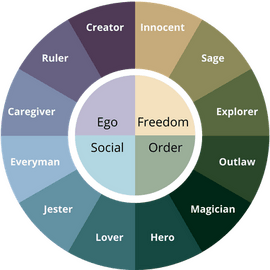
Ego – Hero, Magician, Outlaw
Order – Caregiver, Creator, Ruler
Social – Lover, Jester, Everyman
Freedom – Innocent, Sage, Explorer
Jung believed that each individual has a unique combination of archetypes that make up their personal psyche. While some archetypes may be more dominant or active at certain times, he did not necessarily believe that one archetype would be dominant over all others for an individual’s entire life. Moreover, the archetypes evolve as we do and our capacities develop as this happens and as the range of archetypes available to us expands. The twelve archetypes have important functions not only in individual development, but also in human survival and evolution.
Margaret Mark and Carol Pearson further popularized the 12 Jungian archetypes. They also proposed their own labels for the four categories: independence, belonging, stability, and mastery. Mark and Pearson used a similar matrix. Their categories correspond to those Jungian as follows: Mastery = Ego, Stability = Order, Belonging = Social, Independence = Freedom. Mark and Pearson also tuned the theory of archetypes to marketing needs: The Hero and the Outlaw: Building Extraordinary Brands Through the Power of Archetypes (2001).
The Twelve Jungian Archetypes
Caregiver

The Caregiver is an altruist, moved by compassion, generosity, and selflessness to help others. Although prone to martyrdom and enabling behaviors, the inner Caregiver helps us raise our children, aid those in need, and build structures to sustain life and health. Caregivers first seek to help others, which they do with compassion and generosity. A risk they take is that in their pursuit to help others they may end up being harmed themselves. They dislike selfishness, especially in themselves, and fear what it might make them.
Main goal: To help others, give freely and be recognized for their care and dedication
Fear: Selfishness
Fatal flaw: Tendency to “rescue” people who are detrimental to their mental health
Addiction: Codependency in romantic and platonic relationships
Shadow Side: The suffering martyr, who controls others by making them feel guilty. “Look at all I sacrificed for you!” It evidences itself in all manipulative or devouring behaviors, in which the individual uses caretaking to control or smother others. It is also found in co-dependence, a compulsive need to take care of or rescue others.
The Caregiver may also be known as the caretaker, altruist, saint, parent, helper, or supporter. The Caregiver sees altruism and self-sacrifice as the pinnacles of maintaining the social structure. They are selfless and generous in their actions and wish to make their loved ones fulfilled and happy through their undying care and dedication.
Good for brands that help people care for themselves, serves the public through health care, education or aid programs.
Ruler
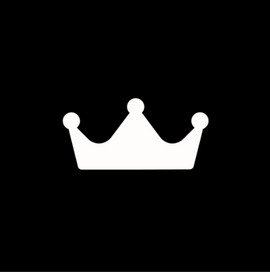
The Ruler archetype inspires us to take responsibility for our own lives, in our fields of endeavor, and in the society at large. If he/she overcomes the temptation to dominate others, the developed Ruler creates environments that invite in the gifts and perspectives of all concerned. The Ruler’s quest is to create order and structure and hence an effective society in which the subjects of the Ruler can live productive and relatively happy lives. This is not necessarily an easy task, as order and chaos are not far apart, and the Ruler has to commit him or herself fully to the task. The buck stops with them and they must thus be wholly responsible – for which they need ultimate authority.
Main goal: To maintain and uphold an orderly life while remaining in control
Fear: Chaos
Fatal flaw: Incapatibility to digest chaos or plan around spontaneity
Addiction: Controlling, adamant behaviors and a looming sense of elitism
Shadow Side: The ogre tyrant, insisting on his or her own way and banishing creative elements of the kingdom (or the psyche) to gain control at any price. This is the King or Queen who indulges in self-righteous rages and yells, “Off with his head.” Often people act this way when they are in positions of authority (like parenting) but do not yet know how to handle the attendant responsibility. This also includes people who are motivated by a strong sense to control.
The Ruler may also be known as the boss, leader, aristocrat, parent, politician, responsible citizen, role model, manager, or administrator. The Ruler seeks to impose order upon the world. They seek rigidity and responsibility to be in total control of their lives and dictate what should – not could – be done. Structure, in the Ruler’s mind, creates the gateway to productivity
Good for brands that offer a sense of security or stability; offer a more orderly and reliable approach. Also offers exclusivity and luxury.
Creator

The Creator archetype fosters all imaginative endeavors, from the highest art to the smallest innovation in lifestyle or work. Adverse to stasis, it can cause us to overload our lives with constant new projects; yet, properly channeled, it helps us express ourselves in beautiful ways. Creators, fearing that all is an illusion, seek to prove reality outside of their minds. A critical part of their quest is in finding and accepting themselves, discovering their true identity in relation to the external world.
Main goal: To create and express their thoughts and feelings through various mediums
Fear: Inauthenticity
Fatal flaw: An abundance of unfinished projects and tendency towards procrastination
Addiction: Overworking, obsessiveness, and tendency towards poverty
Shadow Side: Shows itself to be obsessive, creating so that so many possibilities are being imagined that none can be acted upon fully. (You might remember a film called The Pumpkin Eater, in which a woman got pregnant every time she was face-to-face with the vacuousness of her life. So, too, we can fill our emptiness with yet another inessential project, challenge, or new thing to do, as she filled herself with another baby. One variety of this is workaholism, in which we can always think of just one more thing to do.
The Creator may also be known as the artist, innovator, inventor, musician, writer, or dreamer. At any given time, the Creator has a multitude of projects in the works. Whether it’s to release their stress or spark a sense of meaning, work is their lifeblood. The Creator aims to wholly accept and channel their authentic self towards the external world.
Good for brands that have a desire to differentiate themselves from others through their unique ideas.
Innocent
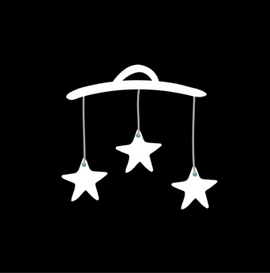
Every era has myths of a golden age or of a promised land where life has been or will be perfect. The promise of the
Innocent is that life need not be hard. Within each of us, the Innocent is the spontaneous, trusting child that, while a
bit dependent, has the optimism to take the journey. The Innocent, fearing abandonment, seeks safety. Their
greatest strength is the trust and optimism that endears them to others and so gain help and support on their quest.
Their main danger is that they may be blind to their obvious weaknesses or perhaps deny them. They can also
become dependent on others to fulfill their heroic tasks.
Main goal: To retain their childlike wonder and cheerfulness to live peacefully
Fear: Abandonment
Fatal flaw: Naivety and denial to the dangers of societal hidden traps
Addiction: Excessive consumerism and dependence on sugary highs
Shadow Side: Evidenced in a capacity for denial so that you do not let yourself know what is really going on. You may be hurting yourself and others, but you will not acknowledge it. You may also be hurt, but you will repress that knowledge as well. Or, you believe what others say even when their perspective is directly counter to your own inner knowing.
The Innocent may also be known as Pollyanna, puer or puella, utopian, traditionalist, naive mystic, saint, romantic, dreamer. Wide-eyed and overly trusting, the Innocent basks in the oblivion of potential threats to live in their imagined utopia. They are prone to indulging in gluttonous behaviors to further distract from the dangers of the world.
Good for brands that portray a sense of nostalgia allowing them to connect with others and be characterized as trustworthy and reliable.
Sage
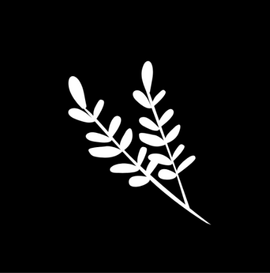
The Sage archetype seeks the truths that will set us free. Especially if the Sage overcomes the temptation of dogma, it can help us become wise, to see the world and ourselves objectively, and to course-correct based on objective analyses of the results of our actions and choices. The Sage is a seeker after truth and enlightenment and journeys far in search of the next golden nugget of knowledge. The danger for the sage and their deep fear is that their hard-won wisdom is built on the sand of falsehood. Their best hope is that they play from a position of objective honesty and learn to see with a clarity that knows truth and untruth.
Main goal: To attain truth, wisdom, and understanding of life’s mysteries
Fear: Deception
Fatal flaw: Lack of empathy, judgementalism and impracticality
Addiction: Being morally correct and promoting objectivity in all situations
Shadow Side: The unfeeling judge—cold, rational, heartless, dogmatic, often pompous—evaluating us or others and
saying we (or they) are not good enough or are not doing it right.
The Sage may also be known as the expert, scholar, detective, oracle, evaluator, advisor, philosopher, researcher, thinker, planner, professional, mentor, teacher, contemplative. Where there is understanding., there is peace. The Sage values knowledge and wisdom above all and will go great lengths to get their hands on books, experiences, and detailed recounts of past events in order to truly make sense of the world.
Good for brands that appeal to logic & attraction to wisdom versus conventional promotion.
Explorer
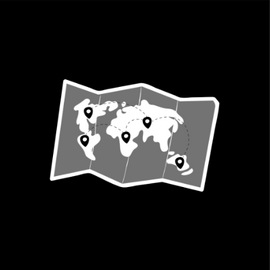
The Explorer leaves the known to discover and explore the unknown. This inner rugged individual braves loneliness and isolation to seek out new paths. Often oppositional, this iconoclastic archetype helps us discover our uniqueness, our perspectives, and our callings. Explorers are looking for something that will improve their life in some way, but in doing so may not realize that they have much already inside themselves. They embrace learning and are ambitious
in their quest and often avoid the encumbrance of support from others. Needing to ‘do it themselves’, they keep
moving until they find their goal (and usually their true self too).
Main goal: To be free to wander and interact with surroundings and discover new findings
Fear: Conformity
Fatal flaw: A sense of ungroundedness; a perpetual feeling of wanderlust
Addiction: Job hopping, extended travel, new experiences, hyper-independen
Shadow Side: The Perfectionist, always striving to measure up to an impossible goal or to find the “right” solution.
We see this in people whose main life activity is self-improvement, going from the health club to yet another self-improvement course, etc., yet who never feel ready to commit to accomplishing anything.
The Explorer also may be known as the seeker, adventurer, iconoclast, wanderer, individualist, pilgrim, quester, antihero, rebel. The Explorer seeks an escape to focus upon the next adventure. Although self-centered in nature, the Explorer acquires knowledge and understanding from their personal experiences and gritty autonomy. Their definition of success can be defined as, “I did it myself”.
Good for brands that have the willingness to take risks in order to discover their authenticity.
Magician
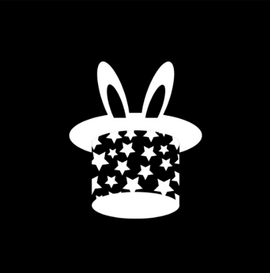
The Magician archetype searches out the fundamental laws of science and/or metaphysics to understand how to transform situations, influence people, and make visions into realities. If the Magician can overcome the temptation
to use power manipulatively, it galvanizes energies for good. The Magician’s quest is not to ‘do magic’ but to
transform or change something or someone in some way. The Magician has significant power and as such may be
feared. They may also fear themselves and their potential to do harm. Perhaps their ultimate goal is to transform
themselves, achieving a higher plane of existence.
Main goal: To transform situations and influence people from their core
Fear: Evil sorcery
Fatal flaw: Tendency towards deception and manipulation of others for their own needs
Addiction: Hallucinogenic substances, witchcraft, alchemy, and mind-altering substances
Shadow Side: The evil sorcerer, transforming better into lesser options. We engage in such evil sorcery anytime we belittle ourselves or another, or lessen options and possibilities, resulting in diminished self-esteem. The shadow Magician is also the part of us capable of making ourselves and others ill through negative thoughts and actions.
The Magician may also be known as the visionary, catalyst, innovator, charismatic leader, mediator, shaman, healer or medicine man or woman. As an emotional alchemist, the Magician fills their brain with psychological tactics and strategies to win friends and ultimately influence people. They enjoy having an upper edge with their charisma and sharp-witted tongue.
Good for brands that try to understand different perspectives and provide guidance where it is needed.
Outlaw
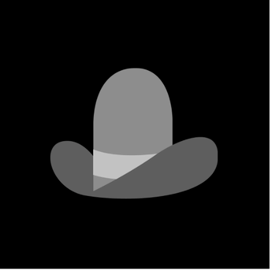
The Outlaw embodies repressed rage about structures that no longer serve life even when these structures still
are supported by society or by our conscious choices. Although this archetype can be ruthless, it weeds the garden
in ways that allow for new growth. The Outlaw is a paradoxical character whose destructiveness reflects the
death drive and an inner fear of annihilation. As a fighter, they are thus careless of their own safety and may put
others in danger too. Their quest is to change, to let go of their anger or whatever force drives them and return to
balance, finding the life drive that will sustain them. Living on the cusp of life and death, they are often surprisingly
humble.
Main goal: To start a riot or revolution to challenge current norms and accepted ideologies
Fear: Annihilation
Fatal flaw: Habitual destruction and ignorance of the law; criminal activity
Addiction: Preaching freedom and new ways of thinking
Shadow Side: Includes all self-destructive behaviors—addictions, compulsions, or activities that undermine intimacy,
career success, or self-esteem—and all behaviors—such as emotional or physical abuse, murder, rape—that have
destructive effects on others.
The Outlaw may also be known as the rebel, the revolutionary, the villain, the wild man or woman, the misfit, the enemy, or the iconoclast. Are rules meant to be broken? Not necessarily, unless if they have to. The Outlaw seeks to destroy and reinvent the wheel for laws they personally see unfit. This often results in chaos, deceit, and mayhem in order to achieve their goals for a better future.
Good for brands that advocate for revolutionary change, despite social norms and popular opinions.
Hero
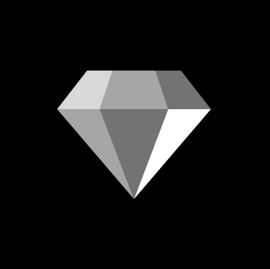
When everything seems lost the Hero rides over the hill and saves the day. Tough and courageous, this archetype
helps us set and achieve goals, overcome obstacles, and persist in difficult times, although it also tends to see others
as enemies and to think in either/or terms. The Hero is relatively simple in their thought patterns, seeking simply to
win whatever confronts them, including the dragons that live inside the mind and their underlying fear of weakness.
Their challenge is to bring meaning to what they do, perhaps choosing their battles wisely, which they do using
courage and the warrior’s discipline.
Main goal: To save the day, a person, or accomplish a lifelong goal
Fear: Weakness
Fatal flaw: Tunnel vision in order to focus upon one objective, fear of failure
Addiction: Ego-feeding and self-validating behaviors, narcissism
Shadow Side: The villain, who uses Warrior skills for personal gain without thought of morality, ethics, or the good of the whole group. It is also active in our lives any time we feel compelled to compromise our principles in order to compete, win, or get our own way. (For example, the shadow Warrior is rampant in the business world today.) It is also seen in a tendency to be continually embattled, so that one perceives virtually everything that happens as a slight, a threat, or a challenge to be confronted.
The Hero may also be known as the warrior, the crusader, the rescuer, the superhero, the soldier, the winning athlete, dragon slayer, the competitor, and the team player. The Hero seeks to fight for justice and the greater good, however “good” is defined in their minds. Through their conquest and journey, they will encounter many hurdles that will test their true character. The Hero is objective-focused and can develop a savior complex.
Good for brands that exemplify mastery to overcome societal adversity, and by doing so, leaving behind a positive and inspiring legacy.
Lover
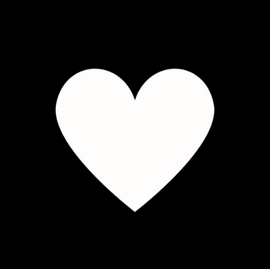
The Lover archetype governs all kinds of love—from parental love, to friendship, to spiritual love—but we know it best
in romance. Although it can bring all sorts of heartache and drama, it helps us experience pleasure, achieve intimacy,
make commitments, and follow our bliss. The Lover seeks the bliss of true love and the syzygy of the divine couple.
They often show the passion that they seek in a relationship in their energy and commitment to gaining the reciprocal
love of another. They fear both being alone and losing the love that they have gained, driving them to constantly
sustain their love relationships.
Main goal: To experience a sense of bliss in their relationships
Fear: Loss of love
Fatal flaw: Objectification of others, and problems with intimacy
Addiction: Relationships, lust, and a tendency to lose oneself in another
Shadow Side: Includes the sirens (luring others from their quests), seducers (using love for conquest), sex or relationship addicts (feeling addicted to love), and anyone who is unable to say no when passion descends, or is totally destroyed when a lover leaves.
Lovers may also be known as partners, friends, intimates, matchmakers, enthusiasts, connoisseurs, sensualists, spouses, team builders, or harmonizers. What is there to live without passion and romance? The Lover seeks to ignite and feed the flames of lust to seek an emotional high after high. Although initially energetic, their struggles with true intimacy can ultimately fence them into short-lived flings.
Good for brands that build strong connections to others making them feel special and appreciated.
Jester

The Jester archetype urges us to enjoy the process of our lives. Although the Jester can be prone to
laziness and dissipation, the positive Jester invites us all out to play – showing us how to turn our work, our
interactions with others, and even the most mundane tasks into FUN. The goal of the Jester is perhaps the
wisest goal of all, which is just to enjoy life as it is, with all its paradoxes and dilemmas. What causes most dread in
the Jester is a lack of stimulation and being ‘not alive’. They must seek to ‘be’, perhaps as the Sage, but may
not understand this.
Main goal: To live in the present and enjoy life without any mental or physical bounds
Fear: Non-aliveness
Fatal flaw: Loss of self-control and the inability to assume responsibility towards anything
Addiction: Hallucinogenic substances, stimulants, depressants, an adrenaline rush
Shadow Side: A glutton, sloth, or lecher wholly defined by the lusts and urges of the body without any sense of dignity or self-control.
The Jester may also be known as the Fool, trickster, joker, punster, entertainer, clown, prankster, practical joker, or comedian. The Jester is essentially a free-wheeling, blatant hedonist who will plot silly pranks simply for the fun of it. The moment is the most important—the past and future are mere illusions that eat away at joy. Even in the most dire of situations, the Jester can always find a way to crack a joke.
Good for brands that see the value in having a good time and relaying that message to others allows others to be more spontaneous in their own lives.
Everyman

The Everyman understands that everyone matters, just as they are. Down-home and unpretentious, it reveals a deep
structure influenced by the wounded or orphaned child that expects very little from life, but that teaches us with
empathy, realism, and street smarts. The Everyman, fearing exploitation, seeks to regain the comfort of the womb and
neonatal safety in the arms of loving parents. To fulfill their quest they must go through the agonies of the
developmental stages they have missed. Their strength is the interdependence and pragmatic realism that they had
to learn at an early age. A hazard is that they will fall into the victim mentality and so never achieve a heroic position.
Main goal: To belong to society and fit in seamlessly; to seek peace and security
Fear: Exploitation
Fatal flaw: Being taken advantage of, sticking out unnecessarily
Addiction: Catering to everyone’s needs in order to maintain their social status
Shadow Side: The victim, who blames his or her incompetence, irresponsibility, or even predatory behavior on others and expects special treatment and exemption from life because he or she has been so victimized or is so fragile. When this Shadow of the positive Orphan is in control of our lives, we will attack even people who are trying to help us, harming them and ourselves simultaneously. Or, we may collapse and become dysfunctional (i.e. “You can’t expect anything from me. I’m so wounded/hurt/incompetent”).
The Everyman may also be known as the good old boy, the regular Jane, Member, Jane or Joe Sixpack, the common man, the guy or gal next door, the realist, the working stiff, the solid citizen, or the good neighbor. The Everyman will do everything in their will to fit in and feel secure in society. They value tradition, loyalty, and safety. When they unintentionally stick out like a fish out of water, they can develop anxious and compulsive behaviors.
Good for brands that give off a sense of belonging that is welcoming and inclusive.
Assessments for Discovering the Active Jungian Archetypes
The 12-archetype model forms the basis for the Pearson-Marr Archetype Indicator® (PMAI®) instrument, which measures archetypes in individuals, and the IBM® Kenexa® Organizational Cultural Insight Survey (IBM-KCIS), which measures them in organizational cultures. Getting reliable data on one’s active archetypes can help you recognize the stories you are unconsciously living and make them conscious.
Your PMAI® results can enable you to make choices that fulfill you as you begin to see your motivations more clearly. Deeper than that, with this information, you can recognize that your archetypes serve as lenses through which you observe the world, which can tip you off to what you are not seeing because it gets filtered out. This, in turn, can improve your relationships as you gain a readily accessible way to notice what archetypes are active in others and thus understand why they think differently than you do. Your results also can inform you about your low scoring archetypes, which can help you comprehend why you may have trouble getting motivated to accomplish certain tasks or have a difficult time dealing with certain people, when the work or the interaction with them requires an archetype that does not come naturally to you.
It is generally agreed that an organization’s culture is a key determinant of whether it is successful or not. However, culture usually is invisible to leaders and employees alike. The IBM-KCIS® decodes cultures, and this information allows the culture’s real values to be identified. Understanding which archetypes generate energy within a group then can be used in branding and marketing, leadership and organizational development, and employee recruitment and retention to support outcomes that are good for the organization and its stakeholders and customers.
What is the Pearson-Marr Archetype Indicator® (PMAI®)?
Both the PMAI® instrument and the IBM-KCIS® have been developed, tested, and refined by the Center for Applications of Psychological Type (CAPT). The PMAI® instrument is the world’s first scientifically validated archetype assessment tool. It opens a window into the patterns of our unconscious stories and provides a path to self-understanding. Once we are aware of the archetypes that are active in our lives, we can decide how and when to use them, and which ones may need nurturing or further development.
Taking a psychometrically sound instrument that points to possible archetype activity provides a framework and method to understand and valuable objective information about the possible roles of archetype-related characteristics in an individual’s life. In conjunction with self-reflection, other information, and – if desired – professional consultation, PMAI® results can offer insight into what archetypes may be active, in the shadows, awaiting expression, idealized, and/or in line with or in contrast to the archetypes in one’s milieu.
Jungian archetypes can provide a different perspective on personality assessment compared to other personality tests like BIG 5, NEO, ORVIS or RIASEC, as they focus on universal symbolic images and the collective unconscious.
